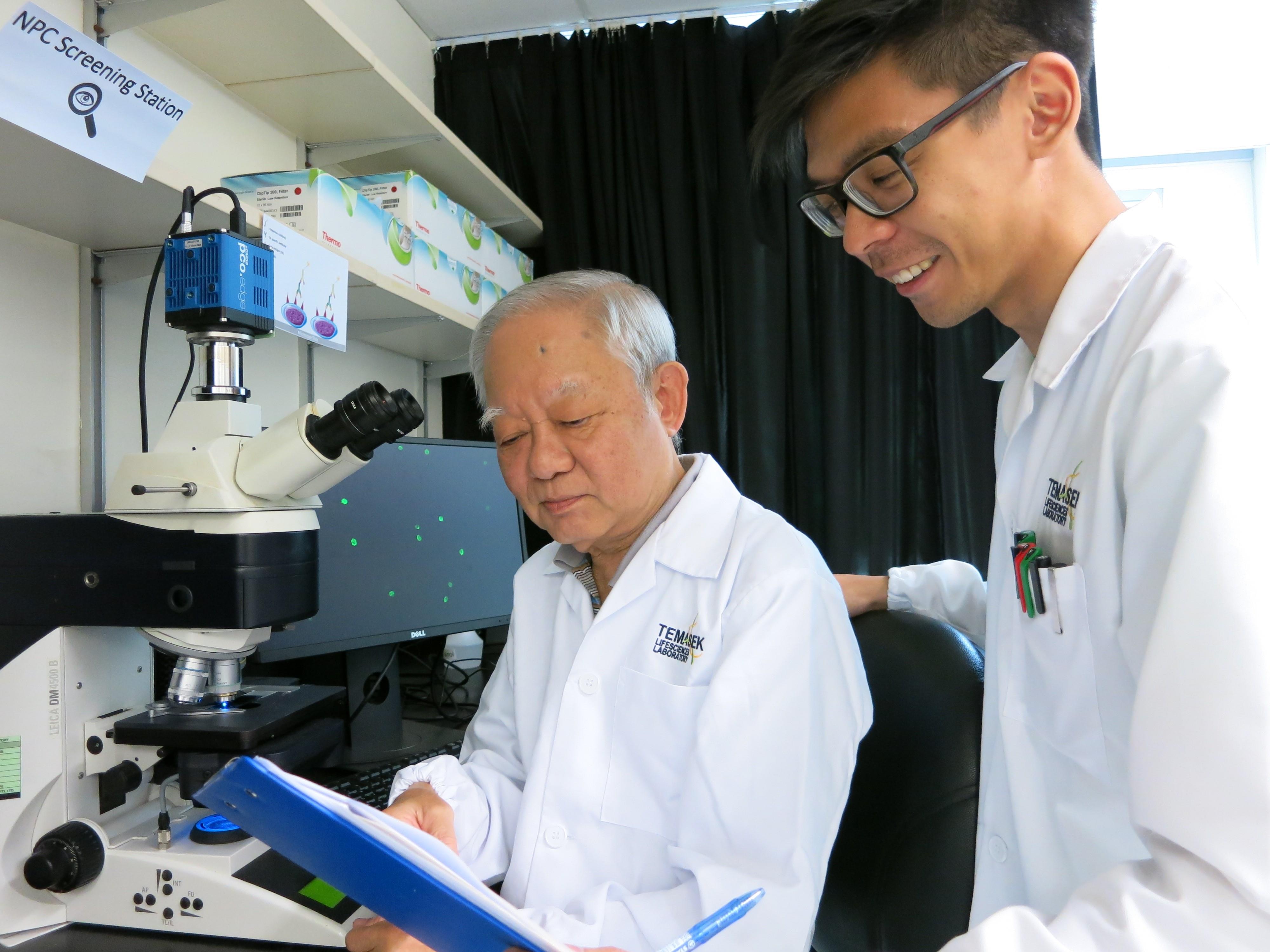Nasopharyngeal cancer (NPC) is the most prevalent cancer amongst Singaporean men aged 40-50, many of whom are breadwinners for their families. Unfortunately, most NPC patients are diagnosed in the later stages when the prognosis for survival is poor whereas
early stage NPC is virtually curable. Accurate early detection can thus save lives and avoid the adverse economic hardship inflicted on their families. To meet this challenge, Emeritus Professor Chan Soh Ha, a pioneer in the field of NPC serology,
together with cancer researcher Temasek Life Sciences Laboratory (TLL) Principal Investigator Dr Ian Cheong, have developed scalable pattern recognition technology to increase the availability of clinical testing for NPC.
The 2010 MOH Clinical Practice Guidelines state that the most predictive test for NPC is the immunofluorescence assay (IFA). For 14 years, Prof Chan was the sole provider of IFA testing in Singapore until his retirement three years ago. Although the IFA is more accurate than existing alternatives, it is also dependent on pathologic interpretation. This scalability bottleneck not only limits the number of tests per year, but has also proven to be a high entry barrier, leaving the IFA currently unavailable in Singapore.
The opportunity to reintroduce the IFA and increase testing availability arose during Prof Chan’s tenure as TLL’s Executive Director two years ago when he started working with Dr Cheong’s research group. Together, they developed an automated platform to identify clear positives and negatives while flagging borderline cases for special pathologic evaluation. The use of imaging technology and pattern recognition simultaneously reduced reagent costs and increased testing throughput several fold. This collaborative effort has resulted in a spin-off start-up named Pathnova Laboratories Pte Ltd, which has licensed this platform from TLL with the goal of improving NPC patient outcomes through timely detection. This project was driven by a multi-disciplinary TLL team, including biomedical engineer Muthukaruppan Swaminathan, and biologists Lee Khai Tuck and Dr Julian Lai U Ming. Pathnova aims to offer the IFA testing service to Singapore hospitals by the end of the year and eventually to make its test available in Southeast Asia and China.
FIND OUT MORE…
About Temasek Life Sciences Laboratory (TLL)
Established in 2002, TLL is a part of Temasek Foundation Innovates, which is one of the six non-profit philanthropic organisations set up by Temasek and sponsored through Temasek Trust.
The TLL research institute houses over 200 researchers from 21 different nations and its vision is to build a preeminent organisation of global talent to undertake bio-molecular science research and applications to benefit people in Asia and beyond. TLL focuses primarily on understanding the cellular mechanisms that underlie the development and physiology of plants, fungi and animals. Such research provides new understanding of how organisms function, and also provides a foundation for biotechnology innovation.
Symptoms and causes of NPC
While the exact cause of NPC has not yet been determined with certainty, NPC has been strongly linked to Epstein-Barr virus (EBV) infection and inherited genetic factors. EBV infection is nearly ubiquitous, but not everyone who is EBV-infected will get NPC and hence testing for EBV alone will yield many false positives. The IFA is useful because it is able to distinguish false positives from true positives with high accuracy. Approximately 75% of NPC patients seek medical attention when they feel a lump or mass in their neck, a point in time when the cancer is likely to have spread. Other symptoms include hearing loss, ringing in the ear, or feeling of fullness in the ear (especially on one side only), recurring ear infections, nasal blockage or stuffiness, nosebleeds, headache, facial pain or numbness, trouble opening the mouth, and blurred or double vision.
Did you know…
The incidence of NPC increases approximately ten-fold from low rates in the North and West to high rates in the South and East regions of China. For example, NPC is the 5th most common and 3rd deadliest male cancer in the Southern province of Guangdong but the incidence rate is 20 times lower in the Northern city of Harbin. One interesting hypothesis is that genetic susceptibility factors in the Southern Chinese population may have been inherited from indigenous ethnic groups in South China and Borneo where NPC rates are very high.
The 2010 MOH Clinical Practice Guidelines state that the most predictive test for NPC is the immunofluorescence assay (IFA). For 14 years, Prof Chan was the sole provider of IFA testing in Singapore until his retirement three years ago. Although the IFA is more accurate than existing alternatives, it is also dependent on pathologic interpretation. This scalability bottleneck not only limits the number of tests per year, but has also proven to be a high entry barrier, leaving the IFA currently unavailable in Singapore.
The opportunity to reintroduce the IFA and increase testing availability arose during Prof Chan’s tenure as TLL’s Executive Director two years ago when he started working with Dr Cheong’s research group. Together, they developed an automated platform to identify clear positives and negatives while flagging borderline cases for special pathologic evaluation. The use of imaging technology and pattern recognition simultaneously reduced reagent costs and increased testing throughput several fold. This collaborative effort has resulted in a spin-off start-up named Pathnova Laboratories Pte Ltd, which has licensed this platform from TLL with the goal of improving NPC patient outcomes through timely detection. This project was driven by a multi-disciplinary TLL team, including biomedical engineer Muthukaruppan Swaminathan, and biologists Lee Khai Tuck and Dr Julian Lai U Ming. Pathnova aims to offer the IFA testing service to Singapore hospitals by the end of the year and eventually to make its test available in Southeast Asia and China.
FIND OUT MORE…
About Temasek Life Sciences Laboratory (TLL)
Established in 2002, TLL is a part of Temasek Foundation Innovates, which is one of the six non-profit philanthropic organisations set up by Temasek and sponsored through Temasek Trust.
The TLL research institute houses over 200 researchers from 21 different nations and its vision is to build a preeminent organisation of global talent to undertake bio-molecular science research and applications to benefit people in Asia and beyond. TLL focuses primarily on understanding the cellular mechanisms that underlie the development and physiology of plants, fungi and animals. Such research provides new understanding of how organisms function, and also provides a foundation for biotechnology innovation.
Symptoms and causes of NPC
While the exact cause of NPC has not yet been determined with certainty, NPC has been strongly linked to Epstein-Barr virus (EBV) infection and inherited genetic factors. EBV infection is nearly ubiquitous, but not everyone who is EBV-infected will get NPC and hence testing for EBV alone will yield many false positives. The IFA is useful because it is able to distinguish false positives from true positives with high accuracy. Approximately 75% of NPC patients seek medical attention when they feel a lump or mass in their neck, a point in time when the cancer is likely to have spread. Other symptoms include hearing loss, ringing in the ear, or feeling of fullness in the ear (especially on one side only), recurring ear infections, nasal blockage or stuffiness, nosebleeds, headache, facial pain or numbness, trouble opening the mouth, and blurred or double vision.
Did you know…
The incidence of NPC increases approximately ten-fold from low rates in the North and West to high rates in the South and East regions of China. For example, NPC is the 5th most common and 3rd deadliest male cancer in the Southern province of Guangdong but the incidence rate is 20 times lower in the Northern city of Harbin. One interesting hypothesis is that genetic susceptibility factors in the Southern Chinese population may have been inherited from indigenous ethnic groups in South China and Borneo where NPC rates are very high.





